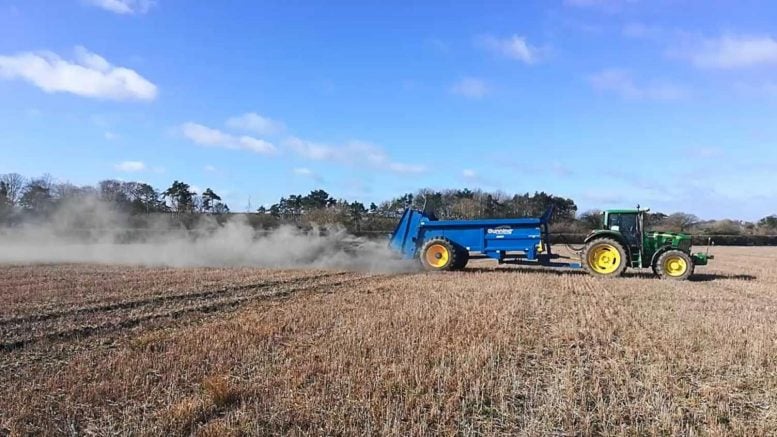
A new study suggests that incorporating crushed rock dust into farmland has the potential to remove up to two billion tonnes of carbon dioxide (CO2) from the atmosphere annually. Credit: Dr Dimitar Epihov
2 Billion Tonnes of CO2 Could be Absorbed From the Atmosphere Each Year by Applying Rock Dust to Farmland
Adding crushed rock dust to farmland could draw down up to two billion tonnes of carbon dioxide (CO2) from the air per year and help meet key global climate targets, according to a major new study led by the University of Sheffield.
- Major new study shows adding rock dust to farmland could remove carbon dioxide (CO2) equivalent to more than the current total emissions from global aviation and shipping combined — or around half of Europe’s current total emissions
- Research identifies the nation-by-nation potential for CO2 drawdown, as well as the costs and the engineering challenges involved
- Findings reveal the world’s highest emitters (China, India, and the US) also have the greatest potential to remove CO2 from the atmosphere using this method
- Scientists suggest unused materials from mining and the construction industry could be used to help soils remove CO2 from the atmosphere
Adding crushed rock dust to farmland could draw down up to two billion tonnes of carbon dioxide (CO2) from the air per year and help meet key global climate targets, according to a major new study led by the University of Sheffield.
The technique, known as enhanced rock weathering, involves spreading finely crushed basalt, a natural volcanic rock, on fields to boost the soil’s ability to extract CO2 from the air.
In the first nation-by-nation assessment, published in Nature, scientists have demonstrated the method’s potential for carbon drawdown by major economies, and identified the costs and engineering challenges of scaling up the approach to help meet ambitious global CO2 removal targets. The research was led by experts at the University of Sheffield’s Leverhulme Centre for Climate Change Mitigation, and the University’s Energy Institute.
Meeting the Paris Agreement’s goal of limiting global heating to below 2C above pre-industrial levels requires drastic cuts in emissions, as well as the active removal of between two and 10 billion tonnes of CO2 from the atmosphere each year to achieve net-zero emissions by 2050. This new research provides a detailed initial assessment of enhanced rock weathering, a large-scale CO2 removal strategy that could make a major contribution to this effort.
The authors’ detailed analysis captures some of the uncertainties in enhanced weathering CO2 drawdown calculations and, at the same time, identifies the additional areas of uncertainty that future work needs to address specifically through large-scale field trials.
The study showed that China, the United States, and India – the highest fossil fuel CO2 emitters – have the highest potential for CO2 drawdown using rock dust on croplands. Together, these countries have the potential to remove approximately 1 billion tonnes of CO2 from the atmosphere, at a cost comparable to that of other proposed carbon dioxide removal strategies (US$80-180 per tonne of CO2).
Indonesia and Brazil, whose CO2 emissions are 10-20 times lower than the US and China, were also found to have relatively high CO2 removal potential due to their extensive agricultural lands, and climates accelerating the efficiency of rock weathering.
The scientists suggest that meeting the demand for rock dust to undertake large-scale CO2 drawdown might be achieved by using stockpiles of silicate rock dust left over from the mining industry, and are calling for governments to develop national inventories of these materials.
Calcium-rich silicate by-products of iron and steel manufacturing, as well as waste cement from construction and demolition, could also be processed and used in this way, improving the sustainability of these industries. These materials are usually recycled as low-value aggregate, stockpiled at production sites, or disposed of in landfills. China and India could supply the rock dust necessary for large-scale CO2 drawdown with their croplands using entirely recycled materials in the coming decades.
The technique would be straightforward to implement for farmers, who already tend to add agricultural lime to their soils. The researchers are calling for policy innovation that could support multiple UN Sustainable Development Goals using this technology. Government incentives to encourage agricultural application of rock dust could improve soil and farm livelihoods, as well as reduce CO2, potentially benefiting the world’s 2.5 billion smallholders and reducing poverty and hunger.
Professor David Beerling, Director of the Leverhulme Centre for Climate Change Mitigation at the University of Sheffield and lead author of the study, said: “Carbon dioxide drawdown strategies that can scale up and are compatible with existing land uses are urgently required to combat climate change, alongside deep and sustained emissions cuts.
“Spreading rock dust on agricultural land is a straightforward, practical CO2 drawdown approach with the potential to boost soil health and food production. Our analyses reveal the big emitting nations – China, the US, and India – have the greatest potential to do this, emphasizing their need to step up to the challenge. Large-scale Research Development and Demonstration programs, similar to those being pioneered by our Leverhulme Centre, are needed to evaluate the efficacy of this technology in the field.”
Professor Steven Banwart, a partner in the study and Director of the Global Food and Environment Institute, said: “The practice of spreading crushed rock to improve soil pH is commonplace in many agricultural regions worldwide. The technology and infrastructure already exist to adapt these practices to utilize basalt rock dust. This offers a potentially rapid transition in agricultural practices to help capture CO2 at large scale.”
Professor James Hansen, a partner in the study and Director of the Climate Science, Awareness and Solutions Program at Columbia University’s Earth Institute, said: “We have passed the safe level of greenhouse gases. Cutting fossil fuel emissions is crucial, but we must also extract atmospheric CO2 with safe, secure, and scalable carbon dioxide removal strategies to bend the global CO2 curve and limit future climate change. The advantage of CO2 removal with crushed silicate rocks is that it could restore deteriorating top-soils, which underpin food security for billions of people, thereby incentivizing deployment.”
Professor Nick Pidgeon, a partner in the study and Director of the Understanding Risk Group at Cardiff University, said: “Greenhouse gas removal may well become necessary as we approach 2050, but we should not forget that it also raises profound ethical questions regarding our relationship with the natural environment. Its development should therefore be accompanied by the widest possible public debate as to potential risks and benefits.”
Reference: “Potential for large-scale CO2 removal via enhanced rock weathering with croplands” by David J. Beerling, Euripides P. Kantzas, Mark R. Lomas, Peter Wade, Rafael M. Eufrasio, Phil Renforth, Binoy Sarkar, M. Grace Andrews, Rachael H. James, Christopher R. Pearce, Jean-Francois Mercure, Hector Pollitt, Philip B. Holden, Neil R. Edwards, Madhu Khanna, Lenny Koh, Shaun Quegan, Nick F. Pidgeon, Ivan A. Janssens, James Hansen and Steven A. Banwart, 8 July 2020, Nature.
DOI: 10.1038/s41586-020-2448-9









You are going to burn a lot of diesel fuel moving and spreading billions of tons of rock dust. Crushing and transporting rock is a very energy intensive process.
It would probably help with the global warming. But so much carbon dioxide has already been added to the atmosphere that climate modification using aerosol spraying to block solar radiation reaching the ground should be started now. That will stop the temperature from continuing to increase, while efforts to reduce carbon dioxide production are begun.
Without active measures to cool the planet by reducing solar heating, the temperature will continue to go up, probably at an increasing rate. That will melt the permafrost, releasing hundreds of billions of tons of additional greenhouse gas. The result will make much of the planet uninhabitable for humans, due to excessive heat, and flooding of coastal cities.
The time to begin doing this is rapidly running out, because fossil fuels will continue to be burned for a long time, outside the rich countries. Billions of people aren’t going to volunteer to be poorer and hungry in order to save the climate in the future. They have to survive today first.
We have to remember that once carbon dioxide is produced, it stays in the atmosphere for centuries. So even if we could stop using fossil fuels soon, which we can’t for economic reasons, the planet will continue to get hotter for a century, or longer. Active climate management is the only way to prevent a catastrophe now. Too much carbon dioxide has already been added to the atmosphere, too quickly to avoid what is coming if we do nothing but lower existing emissions. It’s already too late for that solution alone to work.
Indeed, the irony is that burning coal not only releases CO2 and other nasty stuff, it also releases sulfates that block the sun covering up half the CO2 warming damage. As soon as coal burning is turned off, we should see a spike in warming, unintended consequences. So we will have to up the ante to compensate for that.
“The technique, known as enhanced rock weathering, involves spreading finely crushed basalt,…”
Basalt is almost never used in construction, except perhaps occasionally, as a polished, decorative facade! Similarly, basalt rarely hosts or even caps resources that are mined. It may be quarried for rip-rap along shorelines or used as ‘ballast’ rock for rail-lines. However, its use pales in comparison to the use of limestone (which gives off CO2 when exposed to rain)for making cement and as a flux for iron smelting. Recycling demolished concrete buildings will give mixed results because while there are calcium silicates (such as wollastonite)there are also calcium carbonates that will give off CO2 when exposed to rain. One needs to be mindful of what adding rock dust does to the pH of the soil. One needs to also be careful that there aren’t toxic metals present in the iron slag. Mining and crushing basalt purposely for “enhanced rock weathering” will only add to the issue of CO2 release!
True, i would like to see if granite produces similar results!
Granite will not produce results similar to basalt. The essential quartz is virtually unreactive on less than geologic time scales, and the sodium and potassium silicates (feldspars) react much more slowly than the calcium-bearing feldspars and ‘pyroboles’ found in basalt.
I thought the article would be about biochar.
This method seems to have far less potential than biochar, but it is worth an article.
This is awsome.Also this needs to be done.save our atmosphere!
Too late.
Enough Co2 ppm in the atmosphere for us to reach pliocene like temperatures and sea level rise by 2030. Abrupt climate change is real and has happened before.
It’s unfortunate that the article repeats multiple times that crushed silicate spread on cropland would remove CO2, without once explaining to non-chemists how the process actually works.
Fixed it myself:”ERW [enhanced rock weathering] liberates base cations, generating alkalinity, so that atmospheric CO2 is converted into dissolved inorganic carbon (principally hydrogen carbonate ions; HCO3−) that is removed via soil drainage waters. These weathering products are transported via land surface runoff to the oceans with a storage lifetime exceeding 100,000 years”
Look up ‘mineral sequestration’. It is the natural weathering of rock that removes CO2 long term as the basaltic lava’s (which have had the CO2 of carbonates released by heat) react with CO2 in the air to produce carbonates again. But natural weathering is a very slow process. Grinding the rock to fine particles speeds up the process to human time scales (though it still isn’t what you would call rapid.
My question too. Thanks.
Fixed it myself:”ERW [enhanced rock weathering] liberates base cations, generating alkalinity, so that atmospheric CO2 is converted into dissolved inorganic carbon (principally hydrogen carbonate ions; HCO3−) that is removed via soil drainage waters. These weathering products are transported via land surface runoff to the oceans with a storage lifetime exceeding 100,000 years”
This sounds like a Hazmat accident of vast proportions. Mining and demolition waste? This is about the stupidest idea to come along at least in the last week. No, poisoning the farmland is a bad idea? I’m sure some azz hat has some slides talking about ppm’s and not known to cause cancer, and other vague claptrap of that nature, I’ve heard it all before, just say NO.
“Cement dust inhalation is associated with an increased prevalence of chronic respiratory symptoms and a reduction of ventilatory capacity.” “Studies of ash exposure related to volcanic activity among the residents of the Etna area (Sicily, Italy) have shown an increase in the rate of acute respiratory and cardiovascular diseases.” “Professional exposure to basaltic rock dust: The elements found most frequently were C, Na, Mg, Al, Si, K, Ca, Ti, Mn, Fe and O. All four dusts were toxic: basalt and ash were significantly less toxic than basalt + cement and cement, which shared a similar and very high degree of toxicity.”
mark
The inhalation of ANY kind of dust can be detrimental to breathing creatures. That includes saw dust, flour dust, and road dust. It can be particularly problematic for things like minerals that have distinct cleavage and produce sharp particles. It is a common problem for which there are distinct names such as “black lung,” silicosis, asbestosis, etc. The authors are being cavalier about the practical aspects of implementing their theoretical solution.
The idea is the only real ‘geoengineering’ with the potential to make a difference. The idea of using waste rock dust is new to me as I didn’t realise that there was that much basalt crushed. Basalt rock is prevalent everywhere so no problem finding suitible quaries. It may have to be (and should be) supplemented by ‘excess power generation’ from renewables, perhaps with some short term storage that operates when there is an excess of power as the crushing of the stone is the major barrier to adoption. But the minerals that it would add would be worth it to the farmer who will get other benefits such as conditioning of the soil.
Ian
Get back to us after you have researched the availability of basalt dust and the cost of transporting it to the agricultural fields where it is needed.
Great idea… But.. The use of silica/rock dust is well known for causing IPF. I know this because my dad had a transplant and later died due to it. This was even with respirators, but just over a long period of time.
And what about Photosynthesis taking care of CO2 over time? Just plant a lot of plants, ones that were there before mass agriculture. Plants will absorb and hold the CO2. CO2 + H20 + sunlight = O2 + carbs